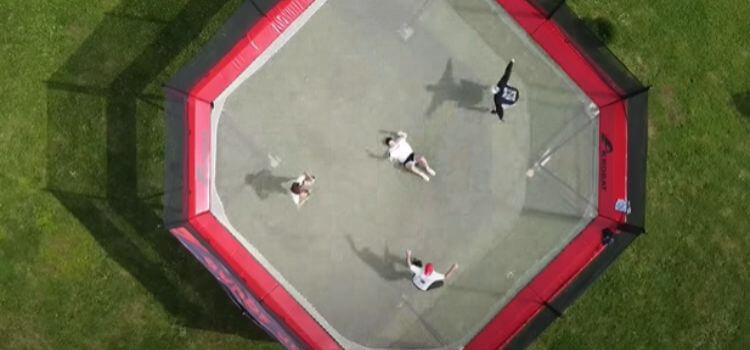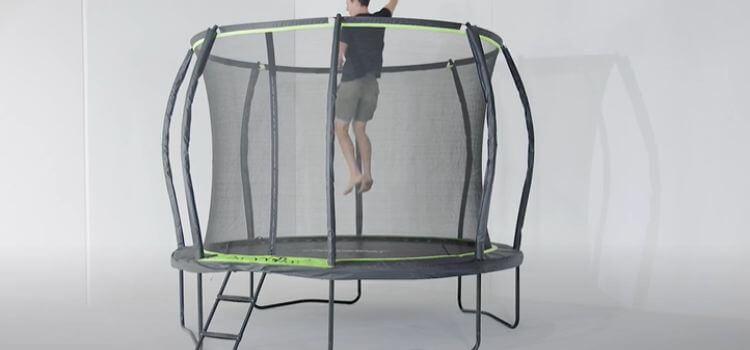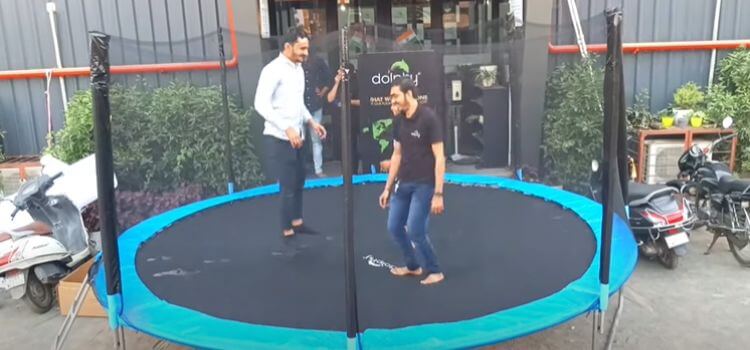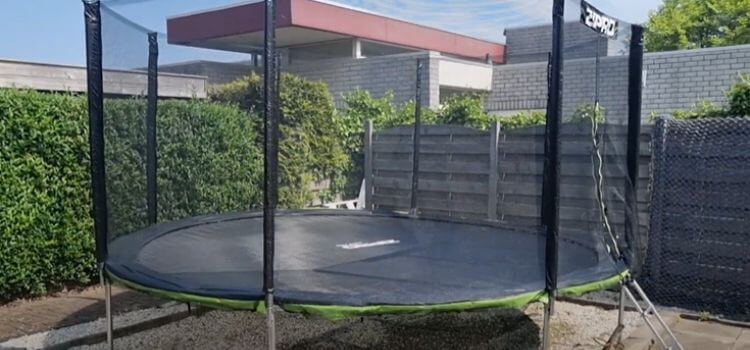As an Amazon Associate, I earn from qualifying purchases.
Trampolines provide endless entertainment and exercise benefits, but understanding their dimensions is crucial for safe usage, maintenance, and placement. The circumference of a trampoline—specifically a 14-foot trampoline—is often a point of interest, particularly for those planning backyard setups, choosing safety enclosures, or determining space requirements.
In this article, we’ll dive into the specifics of calculating a trampoline’s circumference, understand the key factors to consider with different trampoline sizes and highlight some safety tips to ensure your trampoline is both fun and secure. Let’s explore the math behind trampoline measurements, along with practical advice for trampoline owners.
Understanding Trampoline Circumference and Diameter

What is Circumference?
The circumference of a trampoline refers to the entire outer edge or perimeter of the circular trampoline. It’s a valuable measurement because it helps determine space requirements and plays a role in the assembly of trampoline parts, like safety nets and padding.
Calculating the Circumference of a 14 ft Trampoline
To calculate the circumference of a 14-foot trampoline, it’s important to understand the mathematical relationship between the diameter and circumference of a circle.
Formula for Circumference: Circumference (C) = π × Diameter (D)
Diameter of a 14 ft Trampoline: The diameter is already provided as 14 feet.
Applying the Formula:
Using π ≈ 3.1416, the circumference of a 14-foot trampoline is:
C=π×14≈3.1416×14≈43.98 feet = π × 14 \approx 3.1416 × 14 \approx 43.98 \text{ feet}C=π×14≈3.1416×14≈43.98 feet
So, the circumference of a 14-foot trampoline is approximately 44 feet.
Why Knowing the Circumference of Your Trampoline Matters

Understanding the circumference of your trampoline is essential for several reasons:
Safety Enclosures: Many safety nets require accurate circumference measurements to ensure a snug fit around the trampoline’s frame.
Protective Padding: Circumference helps determine the length of padding needed to cover the springs and frame for added safety.
Yard Placement: Knowing the outer perimeter can help ensure that the trampoline is placed in a safe, spacious area, minimizing collision risks with surrounding objects.
Accessory Compatibility: Accessories like covers, tarps, and custom enclosures may also depend on accurate circumference measurements.
Other Important Trampoline Measurements

While the circumference is vital, other dimensions are equally important to ensure your trampoline setup is safe and optimal.
Diameter
The diameter represents significant insight into the width of the trampoline from edge to edge, passing through the center.
For a 14-foot trampoline, the diameter is straightforwardly 14 feet.
Frame Size
Trampoline frames vary depending on their style (round, rectangular, or square). Knowing your frame size is essential when buying replacement parts or accessories.
Mat Size
The mat size is slightly smaller than the frame size due to the springs. For a 14-foot frame, the mat may measure around 12-13 feet depending on the spring length.
Factors to Consider When Choosing a 14 ft Trampoline

Space Requirements
Outdoor Area: A 14-foot trampoline requires at least 2-3 feet of clearance on all sides. Ensure you have adequate outdoor space before purchasing a trampoline of this size.
Indoor Setup: If used indoors (typically for smaller trampolines), verify that ceiling height and surrounding space accommodate the trampoline’s circumference and user movement.
Weight Capacity
Larger trampolines, like a 14-foot model, often support multiple users and higher weight limits. One of the most crucial concerns always checking the weight capacity for safety.
Safety Features
For a 14-foot trampoline, safety nets, spring covers, and durable padding are essential to prevent falls and injuries.
Safety Tips for Using a 14 ft Trampoline
Safety is a top priority when it comes to trampoline use, especially with larger models.
Install Safety Enclosures
Safety nets are a must for trampolines, especially for children. A correctly sized enclosure net keeps jumpers from accidentally falling off.
Ensure Proper Padding
Spring covers and frame padding reduce the risk of injury. Measure carefully, ensuring padding fits around the entire 44-foot circumference.
Regular Inspections
Inspect the trampoline periodically for wear and tear, especially on the springs, frame, and mat. A 14-foot trampoline experiences high impact due to its size and user capacity.
Adult Supervision
Supervise children and inexperienced jumpers, ensuring only one user at a time, if possible, to reduce collision risks.
Popular 14 ft Trampoline Features

Many 14-foot trampolines come equipped with helpful features to enhance user experience and safety.
Heavy-Duty Frame
Many 14-foot trampolines are built with galvanized steel frames for durability, weather resistance, and added weight capacity.
UV-Resistant Mats
Larger trampolines often feature UV-resistant mats to withstand long-term sun exposure, ideal for outdoor setups.
High Bounce Springs
A larger trampoline diameter typically means more springs, resulting in better bounce quality. For example, a 14-foot trampoline may have 84-96 springs, enhancing jump height.
Frequently Asked Questions
What Age is Appropriate for a 14-foot Trampoline?
A 14-foot trampoline is generally suitable for older children (ages 6+) and adults due to its large size and bounce potential. Always check the manufacturer’s age recommendations, as some models may be safer for younger children if they have additional safety features like lower bounce springs or tighter enclosures.
How much is the exact Weight Capacity of a 14-foot Trampoline?
Weight capacities vary by model and manufacturer, but most 14-foot trampolines support between 250 to 400 pounds. If you plan to have multiple users on the trampoline, look for models with higher weight capacities and reinforced frames to ensure stability.
How Many Springs Should a 14-Foot Trampoline Have?
Most 14-foot trampolines have between 84 to 96 springs. More springs typically provide a better, more even bounce. Spring quality is also important—look for models with rust-resistant, galvanized springs for durability and consistent performance.
Is Padding Particularly Necessary for the Springs and Frame?
Yes, padding is essential for protecting users from the springs and frame. Look for high-density foam padding that covers the springs and frame edges, as it reduces the risk of injury during use. Ideally, padding should be UV- and weather-resistant to maintain its quality outdoors.
How Long Does a 14-Foot Trampoline Last?
The lifespan of a 14-foot trampoline depends on its various qualities, materials, and proper flexible maintenance. With proper care, high-quality trampolines can last 5-10 years. Regularly checking for rust, wear, and tear and using a weather cover during harsh seasons can extend its life.
How Do I Keep the Trampoline in Good Condition Year-Round?
To maintain your trampoline year-round, consider using a weatherproof cover when not in use, especially during rainy or snowy seasons. Regularly check and replace any damaged parts, keep them clean by removing debris, and ensure it’s properly anchored to withstand winds and storms.
Conclusion
The circumference of a 14 ft trampoline is approximately 44 feet, a critical measurement for anyone planning to purchase, assemble, or accessorize this trampoline size. Knowing the circumference helps ensure the proper fit for safety enclosures, padding, and placement within your yard or space. Alongside circumference, understanding additional measurements like diameter, frame size, and mat dimensions ensures a safe and enjoyable experience for all users.
As an Amazon Associate, I earn from qualifying purchases.
Leave a Reply